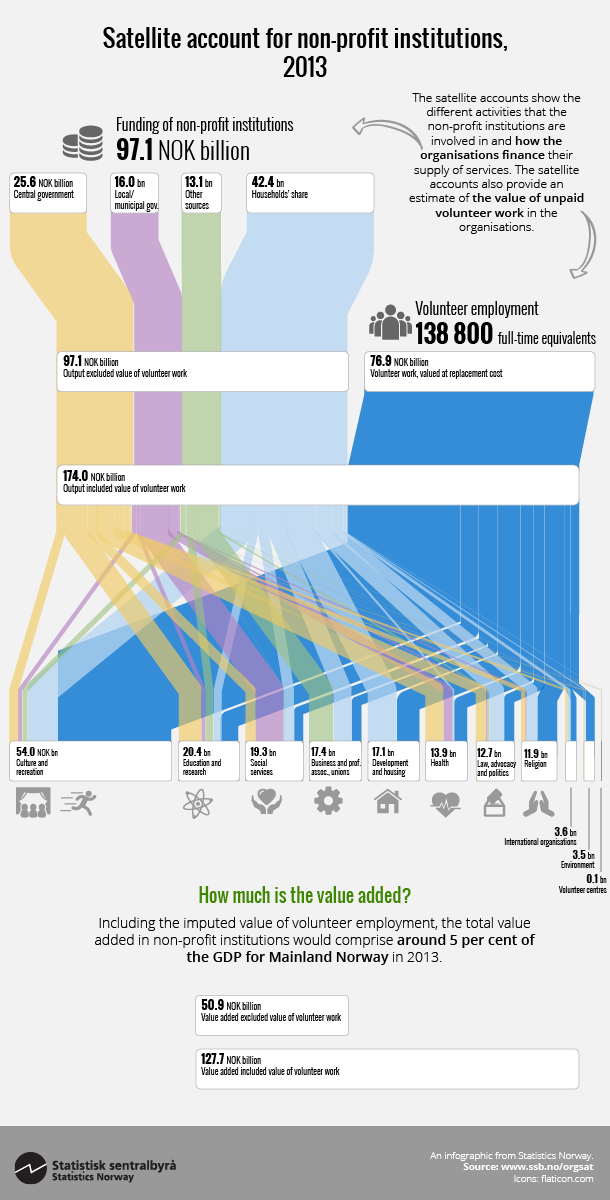Content
Published:
This is an archived release.
Volunteer work valued at almost NOK 77 billion
A new study of voluntary work in Norway indicates that unpaid volunteer employment constituted almost 140 000 full-time equivalents (FTEs) in 2013. Valued at the cost of replacing the unpaid FTEs with hired workers, the volunteer employment was worth approximately NOK 77 billion.
| 2011 | 2012 | 2013 | |
|---|---|---|---|
| Output. NOK million | 86 821 | 90 510 | 97 122 |
| Value added. NOK million | 45 890 | 47 674 | 50 881 |
| Full-time equivalent persons (paid employees) | 82 768 | 83 278 | 84 313 |
| Percentage of GDP | |||
| Value added as share of GDP. Percentage | 1.8 | 1.7 | 1.7 |
| Value added as share of GDP Mainland Norway. Percentage | 2.2 | 2.2 | 2.2 |
| Full-time equivalent persons (paid employees) as share of total full-time equivalent persons in Norway. Percentage | 3.6 | 3.6 | 3.6 |
| Sources of income for non-profit institutions | |||
| Central government’s share of total funding. Percentage | 25.8 | 26.4 | |
| Local/municipal governments’ share of total funding. Percentage | 17.5 | 16.4 | |
| Households’ share of total funding. Percentage | 38.5 | 43.6 | |
| Other sources of funding. Share of total funding. Percentage | 18.2 | 13.6 |
Excluding the volunteer work, the non-profit institutions are estimated to have contributed NOK 51 billion, or 1.7 per cent, to the gross domestic product (GDP). Including the value of unpaid work, the total value added in the non-profit sector rises to around NOK 128 billion, or 4.1 per cent of GDP in 2013.
There were just over 84 300 paid FTEs in the sector as a whole; a small increase from the year before. A new study on volunteer work by the Institute for Social Research indicates that there were just over 1.6 unpaid FTEs for every paid FTE in 2013; an increase from around 1.4 from the previous study in 2009. In addition to the volunteer effort, contributions from households covered almost 44 per cent of the organisations´ total operating costs.
Health, social services end education contributes most to value added
The non-profit institutions are involved in a wide array of activities, performing important tasks in the Norwegian welfare society. It was mainly the same activities that contributed the most to total value added in 2013 as in previous years. Health and social services, along with education and research, contributed about 57 per cent of the value added in the non-profit sector, excluding volunteer work. Institutions within the area of culture and recreation contributed just over 13 per cent, while institutions within the other activities contributed approximately 29 per cent in total.
Unpaid employment greatest within the area of culture and recreation
The extent of volunteer employment varies greatly between institutions within the different activities. The most unpaid FTEs behind every paid FTE are found in the category for development and housing, with a ratio of almost 14. The area with the greatest extent of volunteer work is by far culture and recreation, including sports, where almost half of the unpaid FTEs are found. The contribution to the total value added from this category rises to almost 35 per cent when the value of volunteer employment is included. The volunteer employment in sports alone constituted just over 33 300 unpaid FTEs, or around 24 per cent of the total unpaid FTEs.
Income from households covers almost 44 per cent of the organisations´ operating income
The non-profit institutions finance their activities through several different channels, from sales of services to public and private participants, government transfers, membership payments, sponsors, gifts, collections and more. The calculations in this satellite account are intended to show how the organisations finance their operations. Funds for investment purposes or activities abroad are therefore excluded from this framework.
New calculations of the non-profit institutions´ sources of income show that, in addition to the considerable extent of volunteer employment, income from households covers almost 44 per cent of the organisations´ total operating costs. Central and local government contributed around 26 and 16 per cent of the operating costs through transfers and purchase of services, while the remaining 14 per cent was funded by the corporate sector.
The infographic above shows how the funding from the different sources is distributed over the different activities. Of the funding from central and local government, almost 73 per cent went to institutions supplying welfare services such as health and social services, education and research. The funds from the central government are mainly directed towards health and education, while the funding from local government mostly targets social services and nursing homes. Approximately 11 per cent of the public transfers went to culture and recreational activities. Organisations within culture and recreation obtain most of their income from households, around 62 per cent. Of the total transfers from households just over NOK 10 billion, or 24 per cent, went to culture and recreation. The funding from the corporate sector was mainly targeted towards business and professional associations, in addition to education and research.
Contact
-
Sindre Midttun
E-mail: sindre.midttun@ssb.no
tel.: (+47) 41 62 78 05
-
Nils Amdal
E-mail: nils.amdal@ssb.no
tel.: (+47) 91 14 91 46

